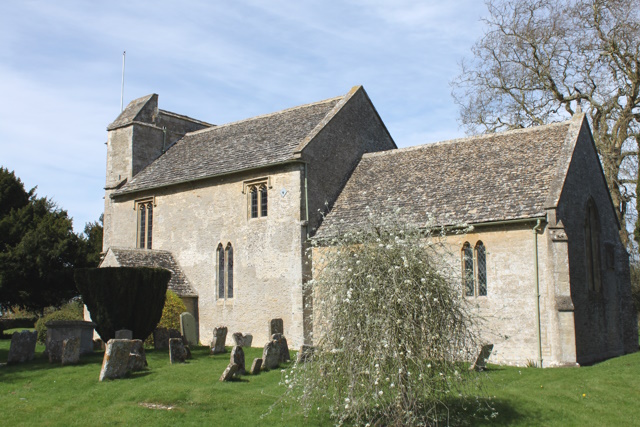


























St. George's Church, Kencot
St George's Church in Kencot was built in the mid 12th century with a small nave and chancel, as can be seen from the nave's walling and proportions, blocked north doorway, shafted jambs of the chancel arch with impost mouldings continued along the nave east wall, and the south doorway which resembles the chancel arch in style and has a figurative tympanum. The carving of a centaur shooting an arrow into the mouth of a dragon has been interpreted, according to the probably later carved legend, as Sagittarius, a subject which recurs on the font at Hook Norton church, also connected with the d'Oilly family. In the 13th century the chancel was rebuilt, the nave remodelled by the insertion of two-light windows, and a two-stage tower added. In the late 13th or early 14th century the chancel was embellished when the chancel arch was modified and a piscina with credence shelf was created; windows were enlarged or replaced in nave, chancel, and tower. Despite a donation to the fabric of a chapel in 1501 the church was not enlarged, though about that time windows to imitate a clerestory were inserted high in the nave's south wall, and a new timber ceiling was constructed from which stone corbels survive. Probably between c. 1509 and c. 1530 Robert Weston, a London mercer, and his wife paid for construction of the south porch and the third stage of the tower (together with its south stairtower) to house the three bells they had donated, one of which survives. Though no building activity was recorded during the 17th or 18th centuries, quite lavish liturgical furnishings were provided. Large items, including a pulpit and a new bowl and cover for the 13th-century font, were installed in the first half of the 17th century presumably to make good damage. At the same period an unusual timber monument with hinged doors was installed to commemorate the non-resident Richard Colchester (d. 1643), son-in-law of the former lord mayor of London Sir Hugh Hammersley: Hammersley was lessee of the manor house, and his family held the advowson. The nave was ceiled in 1814 (renewed in 1962), and the west gallery on classical columns was installed at about that time; the medieval south window lighting it was enlarged in 1854 to give more light to the singers. Heavy mid 19th-century restoration included repewing in 1858, reconstruction of the chancel, and replacement following the two-light pattern of the main nave and chancel windows; the chancel was decorated with stained glass (including the east window by Powell & Sons), and with stencilled designs since removed. The chancel was mainly refurnished during the later 20th century, some of the joinery being the work of Richard Fyson of Manor Farm. In 2000 Sebastian Brooke carved the inner face of the tympanum with a lamb and flag. Historical information about St George's Church is provided by British History Online. Christina Colvin, Carol Cragoe, Veronica Ortenberg, R B Peberdy, Nesta Selwyn and Elizabeth Williamson, 'Kencot: Buildings', in A History of the County of Oxford: Volume 15, Bampton Hundred (Part Three), ed. Simon Townley (London, 2006), pp. 173-177. British History Online http://www.british-history.ac.uk/vch/oxon/vol15/pp173-177 [accessed 3 April 2023]. St George's Church is a Grade II* listed building. For more information about the listing see CHURCH OF ST GEORGE, Kencot - 1053501 | Historic England. For more information about St George's Church see Kencot: Buildings | British History Online (british-history.ac.uk). |

